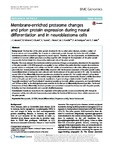Membrane-enriched proteome changes and prion protein expression during neural differentiation and in neuroblastoma cells
| dc.contributor.author | Macedo, JA | |
| dc.contributor.author | Schrama, D | |
| dc.contributor.author | Duarte, I | |
| dc.contributor.author | Tavares, E | |
| dc.contributor.author | Renaut, J | |
| dc.contributor.author | Futschik, ME | |
| dc.contributor.author | Rodrigues, PM | |
| dc.contributor.author | Melo, EP | |
| dc.date.accessioned | 2017-05-09T13:01:28Z | |
| dc.date.available | 2017-05-09T13:01:28Z | |
| dc.date.issued | 2017-04-22 | |
| dc.identifier.issn | 1471-2164 | |
| dc.identifier.issn | 1471-2164 | |
| dc.identifier.other | 319 | |
| dc.identifier.uri | http://hdl.handle.net/10026.1/9203 | |
| dc.description.abstract |
BACKGROUND: The function of the prion protein, involved in the so-called prion diseases, remains a subject of intense debate and the possibility that it works as a pleiotropic protein through the interaction with multiple membrane proteins is somehow supported by recent reports. Therefore, the use of proteomic and bioinformatics combined to uncover cellular processes occurring together with changes in the expression of the prion protein may provide further insight into the putative pleiotropic role of the prion protein. RESULTS: This study assessed the membrane-enriched proteome changes accompanying alterations in the expression of the prion protein. A 2D-DIGE approach was applied to two cell lines after prefractionation towards the membrane protein subset: an embryonic stem cell line and the PK1 subline of neuroblastoma cells which efficiently propagates prion infection. Several proteins were differentially abundant with the increased expression of the prion protein during neural differentiation of embryonic stem cells and with the knockdown of the prion protein in PK1 cells. The identity of around 20% of the differentially abundant proteins was obtained by tandem MS. The catalytic subunit A of succinate dehydrogenase, a key enzyme for the aerobic energy metabolism and redox homeostasis, showed a similar abundance trend as the prion protein in both proteomic experiments. A gene ontology analysis revealed "myelin sheath", "organelle membrane" and "focal adhesion" associated proteins as the main cellular components, and "protein folding" and "ATPase activity" as the biological processes enriched in the first set of differentially abundant proteins. The known interactome of these differentially abundant proteins was customized to reveal four interactors with the prion protein, including two heat shock proteins and a protein disulfide isomerase. CONCLUSIONS: Overall, our study shows that expression of the prion protein occurs concomitantly with changes in chaperone activity and cell-redox homeostasis, emphasizing the functional link between these cellular processes and the prion protein. | |
| dc.format.extent | 319- | |
| dc.format.medium | Electronic | |
| dc.language | en | |
| dc.language.iso | en | |
| dc.publisher | Springer Science and Business Media LLC | |
| dc.subject | Prion protein | |
| dc.subject | 2D-DIGE | |
| dc.subject | Neural differentiation | |
| dc.subject | Chaperone activity | |
| dc.subject | Redox homeostasis | |
| dc.title | Membrane-enriched proteome changes and prion protein expression during neural differentiation and in neuroblastoma cells | |
| dc.type | journal-article | |
| dc.type | Article | |
| plymouth.author-url | https://www.ncbi.nlm.nih.gov/pubmed/28431525 | |
| plymouth.issue | 1 | |
| plymouth.volume | 18 | |
| plymouth.publication-status | Published online | |
| plymouth.journal | BMC Genomics | |
| dc.identifier.doi | 10.1186/s12864-017-3694-6 | |
| plymouth.organisational-group | /Plymouth | |
| plymouth.organisational-group | /Plymouth/Faculty of Health | |
| plymouth.organisational-group | /Plymouth/Users by role | |
| dc.publisher.place | England | |
| dcterms.dateAccepted | 2017-04-08 | |
| dc.identifier.eissn | 1471-2164 | |
| dc.rights.embargoperiod | Not known | |
| rioxxterms.versionofrecord | 10.1186/s12864-017-3694-6 | |
| rioxxterms.licenseref.uri | http://www.rioxx.net/licenses/all-rights-reserved | |
| rioxxterms.licenseref.startdate | 2017-04-22 | |
| rioxxterms.type | Journal Article/Review | |
| plymouth.oa-location | https://bmcgenomics.biomedcentral.com/articles/10.1186/s12864-017-3694-6 |


